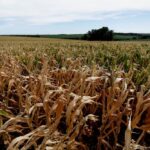MarketsFarm — Updated supply/demand estimates from the U.S. Department of Agriculture on Wednesday included only minor revisions, with the lacklustre report doing little to move the market. While South American production numbers were revised lower, further downward revisions are likely in subsequent reports, according to a market analyst. “We were a little surprised the USDA […] Read more

CBOT weekly outlook: More adjustments expected after lacklustre USDA report

StatsCan confirms tight grain and oilseed stocks
Canadian corn stocks up on year
MarketsFarm — Canada’s tight supplies of canola, wheat and other crops following the 2021 Prairie drought received more confirmation from Statistics Canada with the release of updated stocks data on Tuesday. Canola stocks, as of Dec. 31, 2021, of 7.6 million tonnes were down 43 per cent from the previous year and the tightest since […] Read more

Drought conditions ease slightly across Prairies
MarketsFarm — Mixed precipitation throughout January helped drought conditions improve across much of the Canadian Prairies during the month, according to the latest Drought Monitor report from Agriculture and Agri-Food Canada (AAFC), released Tuesday. Conditions have deteriorated in some areas, however, and the majority of Western Canada was still in some kind of drought state. […] Read more

Pulse weekly outlook: Pulse stocks drop due to drought
MarketsFarm — Statistics Canada’s latest report on stocks of principal field crops clearly demonstrated how much of an effect last summer’s historic drought in Western Canada had on pulse crops. According to the report released Tuesday, last December’s total domestic stocks for dry peas, chickpeas, lentils and soybeans all declined from the year earlier. Those […] Read more

U.S. grains: Soybeans dip ahead of USDA report
Wheat underpinned by U.S. dryness
Chicago | Reuters — Chicago soybean prices fell on Tuesday, a day after hitting an eight-month high, ahead of the U.S. Agriculture Department’s monthly global supply and demand assessment that is expected to downgrade South American crop production. Corn also eased, while wheat firmed, underpinned by ongoing dryness across the U.S. southern Plains. The Chicago […] Read more

Prizes put up to develop year-round berry production in Canada
Weston Foundation's new challenge backed with $33 million
A philanthropic foundation focused on improving public health now wants to improve diets by finding ways to juice up Canada’s home-grown fruit supplies. The Weston Family Foundation on Tuesday pledged $33 million over six years for what it calls the Homegrown Innovation Challenge, a prize challenge pitting ideas against ideas with the goal of extending […] Read more

AgriRecovery underway for flood-battered B.C. farms
Feds, province put up $228 million
The federal and British Columbia governments’ response to last fall’s destructive flooding now includes what’s said to be the biggest farm disaster recovery package in the province’s history. Provincial Agriculture Minister Lana Popham and her federal counterpart Marie-Claude Bibeau on Monday announced cost-shared funding of $228 million for the Canada-B.C. Flood Recovery for Food Security […] Read more

Making it real: Get the lowdown on climate on your farm
Stefan Kienzle has made decades’ worth of very detailed, very local weather data easily accessible
Reading Time: 6 minutes More growing days. Fewer days of frost. And more extreme weather: both drought-inducing heat waves and bitterly cold stretches. That’s the reality of climate change but are those changes happening on your farm? Now you can find out thanks to an easy-to-use website that details precipitation, temperature and growing days on virtually any chunk of […] Read more

Farmers are better able to cope with dry times, say veteran producers
Reducing moisture loss through practices such as no till and rotational grazing are major advances
Reading Time: 3 minutes A series of droughts in the ’80s was a defining event for a generation of Alberta farmers. But two producers who farmed through those times have a hopeful message: Better technology and management practices have put farmers in a much better position to handle extreme weather. “In the mid-’80s — 1982 through 1985 — we […] Read more

PHOTOS: Drill deep into the weather history of your farm
Reading Time: < 1 minute Take a tour of a website that has decades’ worth of weather data for the whole province, including your farm or ranch.

